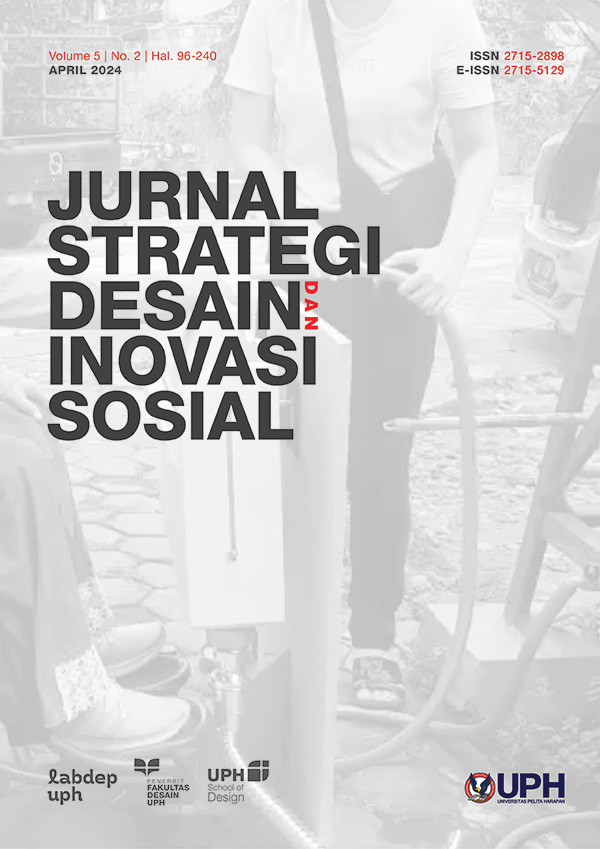Pendekatan Desain Partisipatoris dalam Perancangan Board Game Sebagai Media Pembelajaran Bahasa Indonesia
DOI:
https://doi.org/10.37312/jsdis.v5i2.7969Keywords:
desain partisipatoris, board game, pembelajaranAbstract
Artikel ini membahas mengenai proses perancangan board game yang dilakukan dengan pendekatan desain partisipatoris. Melalui kerjasama dengan Sekolah GenIUS, penulis merancang dua board game yang diharapkan dapat berguna sebagai media penunjang pembelajaran dalam mata pelajaran bahasa Indonesia. Melalui tahapan-tahapan discover, define, develop, dan deliver, penulis menjalankan pendekatan partisipatif untuk bisa menggali dan melibatkan Sekolah GenIUS dalam perancangan yang dilakukan. Hasil dari perancangan ini disambut baik dengan antusiasme siswa-siswi Sekolah GenIUS yang dilibatkan dalam proses perancangan ini. Penulis berharap tulisan ini dapat menjadi referensi dari perancangan dengan menggunakan pendekatan desain partisipatoris, khususnya dalam merancang board game.References
Almulla, M. A. (2020). The Effectiveness of the Project-Based Learning (PBL) Approach as a Way to Engage Students in Learning. SAGE Open, 10(3), 2158244020938702. https://doi.org/10.1177/2158244020938702
Audiah, J., & Hananto, B. A. (2019). Redesain Visual Permainan Kartu “The Art of Batik.” Jurnal Bahasa Rupa, 3(1), 9-21. https://doi.org/https://doi.org/10.31598/bahasarupa.v3i1.392
Bannon, L. J., & Ehn, P. (2013). Design: design matters in Participatory Design. In J. Simonsen & T. Robertson (Eds.), Routledge International Handbook of Participatory Design (pp. 37-63). Routledge.
Hananto, B. A. (2020a). Critical of Design Methodology as Design Education. International Conference on Multimedia, Architecture and Design, 1(October), 234-239. https://eprosiding.idbbali.ac.id/index.php/imade/article/view/370
Hananto, B. A. (2020b). What is Social Visual Communication Design? Proposals on How to Identify and Define it. In J. Selamet, L. T.
Pinasthika, & N. H. Ibrahim (Eds.), Proceedings of the International Conference of Innovation in Media and Visual Design (IMDES 2020) (pp. 27-31). Atlantis Press. https://doi.org/https://doi.org/10.2991/assehr.k.201202.049
Hananto, B. A., Kristella, F., & Violetta, F. (2021). Participatory Visual Communication Design for Designing a Health Information Matching Card Game. Proceedings of the 4th International Symposium of Arts, Crafts & Design in South East Asia (ARCADESA). https://doi.org/http://dx.doi.org/10.2139/ssrn.3807681
Handrianto, C., & Rahman, M. A. (2018). Project Based Learning: A Review of Literature on its Outcomes and Implementation Issues. LET: Linguistics, Literature and English Teaching Journal, 8(2), 110-129. https://doi.org/http://dx.doi.org/10.18592/let.v8i2.2394
Kurikulum Operasional Tahun 2016 Program Studi Desain Komunikasi Visual Program Sarjana pada Fakultas Desain (1st ed.). (2016). Universitas Pelita Harapan.
Latar Belakang. (n.d.). Sekolah GenIUS. Retrieved January 13, 2022, from https://genius.sch.id/latar-belakang/
Program. (n.d.). Sekolah GenIUS. Retrieved January 13, 2022, from https://genius.sch.id/program-kurikulum/
Schlichting, M. (2016). Understanding Kids, Play and Interactive Design: How to Create Games Children Love. Let’s Play Press.
Spinuzzi, C. (2005). The Methodology of Participatory Design. Technical Communication, 52(2), 163-174.
What is the framework for innovation? Design Council’s evolved
Double Diamond. (2015). Designcouncil.Org.Uk. https://www.designcouncil.org.uk/news-opinion/what-framework-innovation-design-councils-evolved-double-diamond
Downloads
Published
Issue
Section
License
Dengan mempublikasikan artikel pada Jurnal Strategi Desain dan Inovasi Sosial (JSDIS), penulis setuju bahwa:
- Penulis memegang penuh hak cipta atas artikel yang dipublikasikan.
- Penulis tidak pernah mempublikaskan artikel penulis dalam publikasi lainnya.
- Penulis dilarang mempublikasikan artikel yang sudah diterbitkan JSDIS tanpa mencantumkan bahwa artikel tersebut sebelumnya sudah pernah diterbitkan di JSDIS.
- Redaksi JSDIS memiliki hak untuk mempublikasikan, mendistribusikan, dan menggunakan artikel penulis untuk keperluan publikasi jurnal dengan tetap mencantumkan penulis sebagai pemegang hak cipta.



.jpg)
